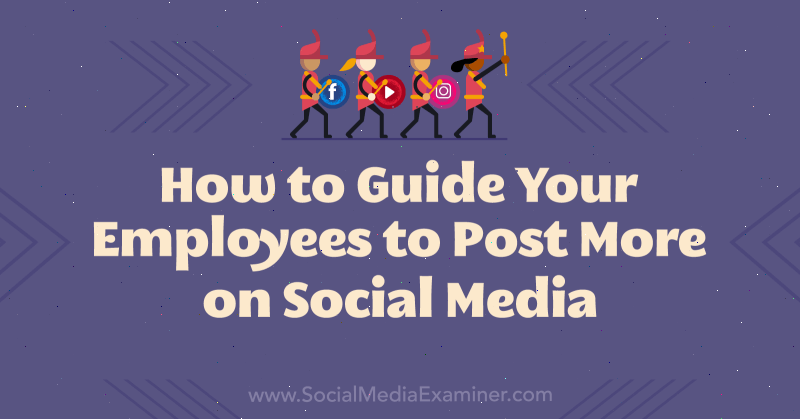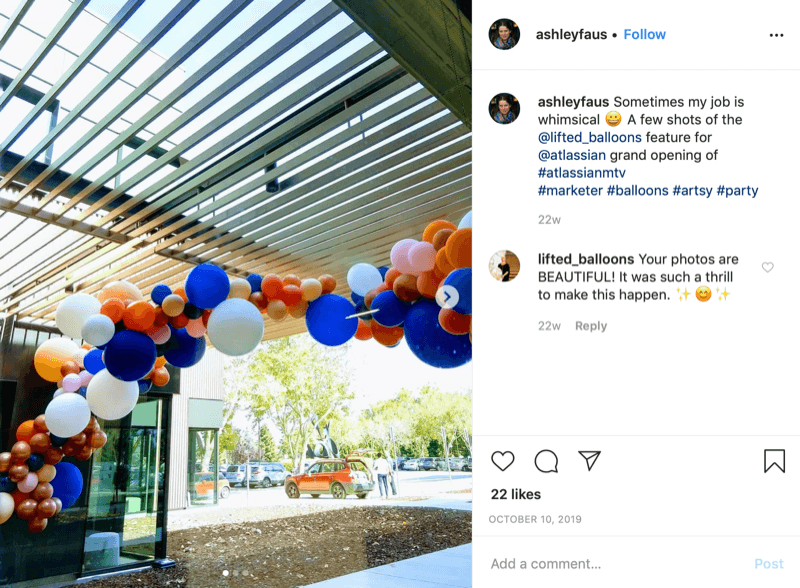Want your employees to share more about your business on social media? Wondering how best to guide their social media posts?
In this article, you'll discover how to develop guidelines to help employees post more on social media and find examples of types of posts employees can model.

#1: Create Clear Social Media Guidelines for Employees to Follow
While marketers might consider social media a second home, the same may not be true for all of your employees and co-workers. Research has shown that a significant number of employees feel their companies haven't given them explicit guidelines for approaching social media. That's one of many reasons why it's a good idea to create a social media guide that will introduce your employees to social media from a professional point of view.
In fact, this was one of the first items my company tackled. We wanted to build our brand on the values of making business personal and human so our social media presence needed to reflect that. We also knew employees needed guidance. As a result, our employees became an important part of our social media strategy.
Employees send the marketing team conference snapshots while on business trips, share personal content from around the office on their own social accounts, and provide commentary on a variety of topics on Twitter. The image in the Instagram post below, for instance, was taken by an employee behind the scenes of an employee photoshoot.

With an increasing number of stories about people being fired for something they've posted online, some employees are reluctant to talk about their work publicly. To ease their concerns and reduce the chances of confidential information leaking out, directly communicate what type of content is never appropriate for employees to post about.
For example, make sure all external communication about new clients is kept under wraps until the contract is officially signed and ensure that communicating financial data is off-limits.
Knowing how nervous employees might be about making a mistake online, MasterCard made their employees an integral part of this process. They held a company-wide meeting and gave employees the opportunity to ask questions about what is and isn't appropriate when taking on the role of a company advocate. The video of this open conversation was later shared among employees globally.
To gather input from your staff, start with a focus group of employees who are already comfortable with social media and discuss how they would approach social media advocacy. Ask for their ideas and concerns. Brainstorm possible topics employees could post about and how they would interact with followers. This candid conversation will be invaluable in shaping company guidelines.
In your guide, make sure to address the following areas.
Engagement Guidance
Once you get your program rolling, you'll be encouraging employees to jump into conversations about your brand online so one part of your social media guidelines should be devoted to rules your employees should adhere to. Here are some key points to address when engaging with customers on social media:
- Identify the types of customers employees should not engage with online. Teach them how to recognize and avoid trolls and other negative comments that don't warrant a response.
- Share your most frequently asked questions (FAQs) and official responses. Having the solutions to problems will give employees the confidence to jump in. Reading the answers to FAQs will also familiarize them with the tone and verbiage used in each situation. However, you don't want everyone to simply repeat the same sentence from the guide. Instead, encourage employees to use their own words when possible.
- Make sure employees only promise what they're certain they can deliver. As the adage goes, it's always better to under-promise and over-deliver.
When it comes to the responses themselves, employees might struggle with striking the right tone between professional and personal. When in doubt, their responses should be factually accurate, respectful, and kind. And of course, correct spelling and grammar are a must.
Get World-Class Marketing Training — All Year Long!
Are you facing doubt, uncertainty, or overwhelm? The Social Media Marketing Society can help.
Each month, you’ll receive training from trusted marketing experts, covering everything from AI to organic social marketing. When you join, you’ll also get immediate access to:
- A library of 100+ marketing trainings
- A community of like-minded marketers
- Monthly online community meetups
- Relevant news and trends updates
Branding Guidance
Also identify key brand elements that employees should pay attention to when communicating with customers on social media. While each employee should make those interactions their own, they should also be mindful of your brand persona and voice, and the feel of your messages and responses online.
If your brand persona involves using business lingo, you might not want employees taking on an irreverent tone. On the flipside, a hip, cheeky brand might not want their employees to use a stiff, professional voice while communicating with customers on social media.
Platform Behavior Guidance
If you want your staff to feel confident enough to share content or engage in conversation with customers online, you have to teach them about the rules of communication on different social media platforms. How often have you seen people sharing content on LinkedIn that's more appropriate for Instagram? To avoid confusion, give platform-specific guidelines to your employees.
#2: Create a Unique, Branded Hashtag to Easily Curate Employee Posts
Creating a unique branded hashtag is a clever way to use hashtags to your advantage. A dedicated hashtag will make it easy to round up the posts your employees have published and reshare them on the company's official account. When someone clicks on your branded hashtag, they'll see a combination of posts that show the other more personal aspect of your brand.

A company that uses this tactic perfectly is Adobe with #AdobeLife. Adobe was one of the first digital companies to actively train employees in brand advocacy on social media. Today, they have close to 900 brand ambassadors in many communities across the world. Adobe briefs brand ambassadors on upcoming products and services, giving them the first opportunity to weigh in online.

Discover Proven Marketing Strategies and Tips
Want to go even deeper with your marketing? Check out the Social Media Marketing Podcast! Publishing weekly since 2012, the Social Media Marketing Podcast helps you navigate the constantly changing marketing jungle, with expert interviews from marketing pros.
But don’t let the name fool you. This show is about a lot more than just social media marketing. With over 600 episodes and millions of downloads each year, this show has been a trusted source for marketers for well over a decade.
However, perhaps the most far-reaching effort so far has been encouraging employees to write for the Adobe Life Blog. They share actionable advice on growing your career in the tech industry and behind-the-scenes glimpses of what it's like to work at Adobe.

Encouraging your employees to use the company hashtag will also make it easier for you to monitor what they're sharing. Despite having the best intentions, sometimes they may not always represent your company appropriately. Regularly reviewing their posts will help you quickly spot content that may be perceived as negative.
You'll also be able to identify employees who have the potential to do more in their role as brand advocates, opening the door for you to provide the appropriate tools and mentoring.
Pro Tip: To ensure employees use your branded hashtag in their company-related posts, consider gamifying or incentivizing their contributions. To illustrate, feature the employee and/or their post in the company magazine or blog, or share their photo on your social accounts.

#3: Encourage Your Employees to Share Day-to-Day Moments From Work
People are much more inclined to engage with social media posts from friends or acquaintances than from brands. Content that isn't heavily branded—not just an advertisement—and that displays the human side of your business is more likely to resonate with consumers.
So how do you achieve this? Encourage your employees to share moments from the office that made them smile or brightened their day. Prompt them to post photos from events like office birthday celebrations or fun observances such as National Cookie Day. If you're a pet-friendly company, post funny or cute pet moments. Also make sure to capture all socially or environmentally responsible events that present a positive brand image overall.

Having your employees actively participate in building your company culture and sharing snippets of it on social media platforms will improve brand awareness and boost your company's image among like-minded consumers.
You can also use your employees to crowdsource your social media content. Create an inbox for interesting photos or designate one team member to be responsible for collecting them. This will allow you to create a feed filled with candid photographs, capturing all of those small moments and interactions in the office or in your place of business that might otherwise go unnoticed.

Share Employee Posts on Your Company Social Media Channels
The best way to signal to your employees that they're a welcome part of your social media presence is by taking that first step and including them and their content in your daily posts.
Don't make a big production out of it. It can be a simple photo of your teammates engaged in some friendly brainstorming with a “taking Monday head-on” caption. Or reshare a homemade video an employee made of your last team-building trip.
UNIQA Insurance Group recently shared a video commemorating International Mother Language Day that was a compilation of clips of employees relaying well wishes in their native languages.

Posts that like this, which are a little imperfect from a technical standpoint but quite heartwarming from the human standpoint, are bound to win the hearts of both your audience and employees.
Conclusion
To better connect with their customers, more than 90% of all brands consider social media a trusted tool. And while an official profile of your brand on a social media platform is a great place to start, you can get better outreach and increased brand awareness by tapping into an asset your company already has—your employees.
Employee advocates on social media can give your business a much-wanted boost but you must communicate what's in it for them throughout this process. Many will appreciate the opportunity to build thought leadership and position their brand alongside the company's. But for those who aren't comfortable sharing work-related posts on their personal profiles, don't pressure them to do so.
To get better results from this initiative, it's important to craft a guide that addresses engagement, branding, and platform-specific interactions and make it available to all employees.
What do you think? Will you encourage your employees to share more about your business on social media? Do you have a guide for them to follow? Share your thoughts in the comments below.
More articles on social media marketing:
- Learn how to create a social media marketing plan.
- Discover how to develop a social media approval process for your company.
- Explore three tools to help you better organize social media posting, monitoring, and campaign execution tasks.
Attention Agency Owners, Brand Marketers, and Consultants

Introducing the Marketing Agency Show–our newest podcast designed to explore the struggles of agency marketers.
Join show host and agency owner, Brooke Sellas, as she interviews agency marketers and digs deep into their biggest challenges. Explore topics like navigating rough economic times, leveraging AI, service diversification, client acquisition, and much more.
Just pull up your favorite podcast app, search for Marketing Agency Show and start listening. Or click the button below for more information.

